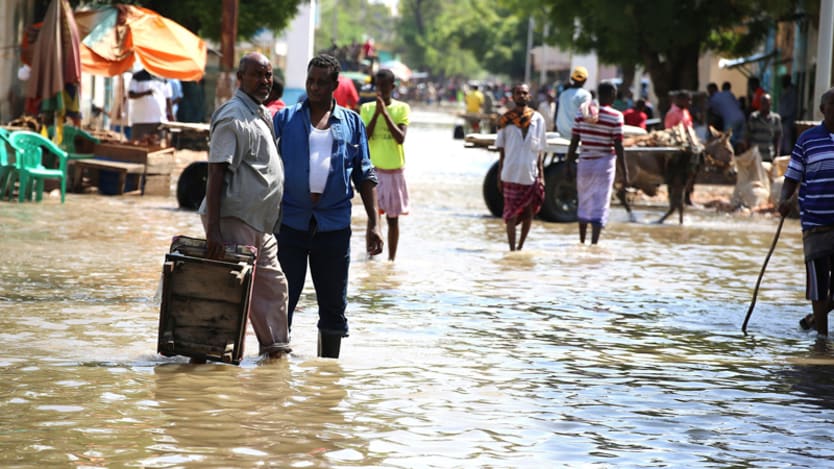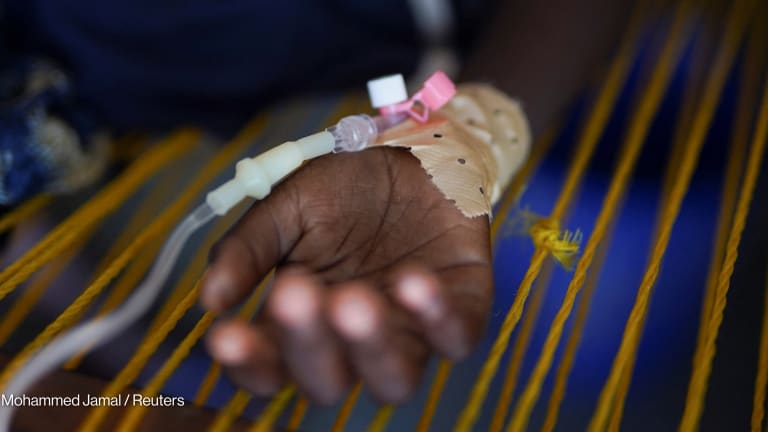
NAIROBI — Torrential rains in East Africa in recent weeks have destroyed homes, crops, and roads, leading to the displacement of hundreds of thousands of people.
In Somalia, two of the largest rivers overflowed, rushing water into neighboring communities. The rains, which began in early March, follow a prolonged drought in the region that has brought widespread food insecurity since late 2016. Areas that have hosted internally displaced populations who fled their homes because of the drought, like Baidoa, in southwestern Somalia, have been especially hard hit by the floods.
“Our staff on the ground have seen the elderly, women, and children struggling to survive while their flimsy shelters are knee-high full of stagnant water. And worst is likely yet to come. Countless displaced communities are sheltering in flood-prone areas,” said Victor Moses, Somalia country director for Norwegian Refugee Council, in a recent press statement.
In Somalia, the floods have displaced more than 175,000, with more than 420,000 further people affected, according to the Somali government. Troops from the African Union Mission in Somalia and Somali national security forces recently evacuated more than 10,000 people to higher ground in Belet Weyne, one of the hardest hit areas. The government has also formed a national disaster committee in response to the crisis.
Across the border in Kenya, the Dadaab refugee camp, which houses nearly a quarter of a million refugees, has also been impacted. Many refugees had to seek shelter in schools after the floods destroyed shelters in the camp.
The Kenya Red Cross Society has been conducting search and rescue missions throughout affected areas, evacuating communities in areas at high risk of flooding. Nearly 260,000 people have been displaced in Kenya from the flooding and an estimated 100 have died.
“When there are no trees or vegetation to secure the soil’s moisture, heavy rains can be as disastrous as drought. Rather than rainfall being absorbed into the soil to nurture crops, the land simply washes away, taking everything in its path,” Caleb Odhiambo, area manager of Save the Children’s Dadaab operation, said in a statement.
The floods have also caused latrines to overflow. As water and sanitation infrastructure is damaged, the humanitarian sector is warning that these floods could lead to widespread outbreaks of diseases such as cholera, which can spread quickly in communities without access to latrines. In Kenya, 33 health centers have been destroyed and in Dadaab camp, children are playing in the contaminated flood water.
Why governments tiptoe around the word 'cholera'
Some governments refuse to acknowledge cholera outbreaks in their country, leaving the humanitarian actors working to respond to the health crisis on a political tightrope.
Massive outbreaks of cholera swept through parts of Africa last year, fueled by drought and conflict. This year, more than 15,000 cases of cholera and ‘acute watery diarrhea’ have already been reported in Eastern and Southern Africa.
“We are also worried that once the rains subsides, people may face an upsurge of mosquito-borne disease such as dengue fever, chikungunya, and malaria. We need to act now to pre-empt these very real, and potentially very deadly threats,” said Dr. Fatoumata Nafo-Traoré, regional director for Africa at International Federation of Red Cross and Red Crescent Societies, in a release.
Heavy rains are forecast to continue throughout the region in the coming weeks. This is expected to make a bad situation worse, said Moses.




